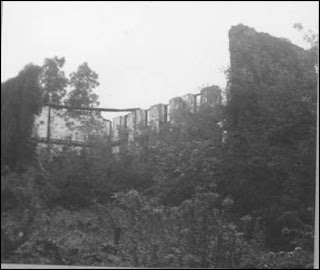Kiamensi Woolen Mill
 |
| Kiamensi Mill employees, 1895 |
Most of the mills mentioned in posts so far, like the Harlan Mill and the England Mill, have been fairly small operations, run by only one or two men. And while most of the mills in the area were like this, there were a few industrial sites that operated on a larger scale. For a good part of the second half of the 19th Century, one of the largest employers in Mill Creek Hundred was the Kiamensi Woolen Company. Situated on Red Clay Creek at Kiamensi Road, just south of Marshallton, the large textile mill and the community it spawned are now nothing more than a vague memory.
The first mill on the site certainly dates from the 1700's, but to be honest, the early history of the millseat is a bit hazy. Scharf gives a fairly detailed account of the ownership of the site, but I think that he might be confusing a few different sites together. (I think the confusion stems from conflating different Red Clay mills, as well as the fact that mills in Stanton (located somewhere behind where Happy Harry's is now) [Edit: See comments below for a correction on the location of this Stanton mill] were later owned by the same company and also referred to as "Kiamensi mills".) He states the mill was owned first by John Reese, who built, likely, a grist mill on the site. In 1811, Reese's son sold the mill to Mordecai McKinney, who according to a DelDot archaeological report, was doing cotton milling at several other nearby sites as well. For the next 20 years, the mill passed through the possession of a number of people with names well known to anyone familiar with Wilmington history -- Lea, Price, Tatnall, and Warner. From then until 1864, the mill was resold no less than seven times. Then, its story really picks up.
In 1864 the Civil War was raging, and the Dean Woolen Company in Newark had lucrative government contracts to supply material for uniforms and blankets. They were looking to expand, and the cotton mill at Kiamensi was what they needed. They purchased the mill, and immediately converted it to a woolen mill. They also purchased two mills in Stanton as companions to Kiamensi, and incorporated them all as the Kiamensi Woolen Company. Weaving and finishing were done at the Kiamensi mill, while carding and spinning were done in Stanton. The mill thrived during the remainder of the war, and, due to its considerable size, was able to weather the post-war downturn much better than many of the other smaller mills in the area.
 |
| Kiamensi Mill, in the left background |
By 1870, the mill employed 40 men and 20 women, and by 1880 had a workforce of 150, although I think that number likely includes the Stanton mills as well. While I can find no direct reference to the size of the Kiamensi mill, the Stanton mill was 100 ft. by 60 ft., and I think the Kiamensi mill was probably of similar size. One report mentions Kiamensi as being five stories tall. In addition to the size of the operation, the other factor that led to the longevity of the mill (it finally closed in 1923) was its proximity to railroad lines. The Wilmington and Western Railroad was built through neighboring Marshallton in 1872, and about ten years later the Baltimore and Ohio Railroad ran its new line directly next to the mill, with a station at the intersection with Stanton Road. These factors allowed the Kiamensi mill to continue as the only woolen mill in Delaware, after the Dean mill burned in 1886.
 |
| Ruins of the mill, 1957 |
By the 1940's, nothing remained of the once bustling mill except a few crumbling foundations and a chimney. The mill community that had sprung up and stretched from the Red Clay Creek to Stanton Road, and had once been home to almost 200 people, was abandoned. Today, very few people realize that this quiet, shady spot along the Red Clay Creek was once a central hub of the textile industry in Delaware.



Comments
Post a Comment